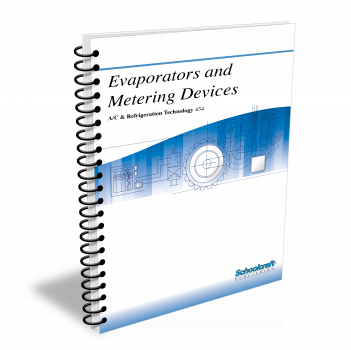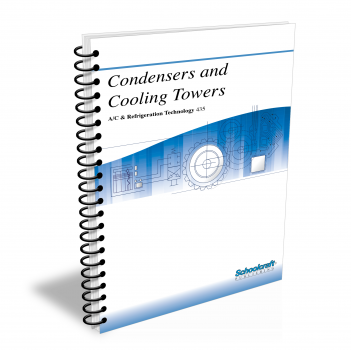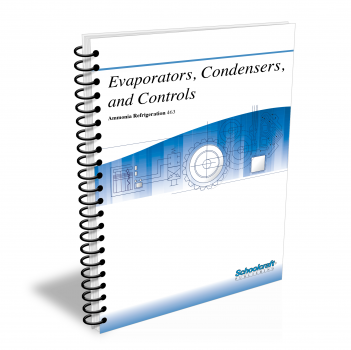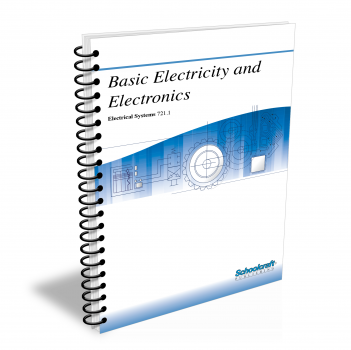Evaporators and Metering Devices

Course Number: 434
The Evaporators and Metering Devices textbook explains the function and construction of evaporators. It covers direct-expansion, dry-expansion, and flooded evaporators, as well as systems using multiple evaporators and ways to boost evaporator performance. It explains evaporator defrosting, maintenance, and troubleshooting, and describes the function, operation, and maintenance of various metering devices, including hand-operated, automatic, thermostatic, thermal-electric devices.
Does your curriculum require additional topics not included in this textbook? Build a customized version of the Evaporators and Metering Devices textbook below.
Recommended Contact Hours – 10
Preview a Chapter
Available Supporting Material
- Table of Contents
- Exam Copies
- Suggested Titles
Table of Contents
Chapter 1: Introduction to Evaporators
Topics: Evaporator operation; Latent and sensible heat; Evaporator capacity; Temperature differential; Circulation velocity
Learning Objectives:
- Explain the function of the evaporator in a refrigeration system.
- List five main factors affecting evaporator capacity, and explain how each can be optimized to gain the greatest possible evaporator capacity.
- Describe the basic evaporator configurations.
- Explain the function of headers and distributors in multiple-circuit evaporators.
- Explain how comfort coolers reduce both air temperature and humidity.
Chapter 2: Direct Expansion Evaporators and Secondary Refrigeration Systems
Topics: Dry and flooded evaporators; Evaporator configurations; Secondary-refrigeration systems; Multiple staging; Cascade systems
Learning Objectives:
- Compare and contrast dry-expansion and flooded evaporators.
- List the main types of flooded evaporators.
- Explain the process of secondary refrigeration.
- Define eutectic solution and eutectic temperature.
- Describe three types of multiple-evaporator systems.
- Identify cascade and multiple-staging refrigeration systems.
Chapter 3: Improving Evaporator Performance
Topics: Net refrigeration effect; Superheating; Subcooling; Accumulators; Heat exchangers; Headers; Oil separation
Learning Objectives:
- Explain how the laws of thermodynamics apply to refrigeration.
- Describe how to increase the net refrigerating effect of an evaporator.
- Demonstrate-using simple arithmetic-the amount of increase in net refrigerating effect caused by subcooling.
- List several advantages of using a heat exchanger in a refrigeration system.
- Describe three ways of keeping oil out of an evaporator.
- Explain why the circulation of air or water through an evaporator coil improves evaporator performance.
Chapter 4: Defrosting, Mainaining, and Troubleshooting Evaporators
Topics: Manual, ambient air, heated air, water, brine, hot-gas, reverse-cycle, and electric defrost methods; Cleaning coils; Frost problems; Troubleshooting
Learning Objectives:
- Explain why periodic defrosting of evaporator coils is necessary.
- List and describe at least five different methods of defrosting an evaporator.
- Explain the differences between the hot-gas and reverse-cycle defrost methods.
- Explain how to clean an evaporator coil, drain pan, and drain line.
- Describe how to remove rust, scale, and sludge from shell-and-tube evaporators.
- List two ways evaporator coils can be winterized.
- Tell how low airflow and excessive moisture increase frost buildup on coil surfaces.
- Explain how dirty coils and damaged fins reduce an evaporator's cooling capacity.
Chapter 5: Metering Device Types, Maintenance and Troubleshooting
Topics: Hand-operated, automatic, thermostatic, and thermal-electric expansion valves; Capillary tubes; Float valves; Maintenance and troubleshooting
Learning Objectives:
- Explain the primary function of a metering device.
- Name the five main types of expansion valve, and describe the operation of each.
- Contrast the operation of an internally equalized and an externally equalized TXV.
- Explain how to adjust the superheat on a TXV.
- Describe the structure, operation, and application of high- and low-side float valves.
- Identify three causes of floodback and describe the corrective action for each.
- List the common problems of TXVs along with their solutions.
Request Exam Copies
Exam Copies
Ready to see a copy of our textbooks? After selecting which textbooks you’d like to review for your course, you can submit your request by either logging in or creating an account so we know where to ship your exam copies. A representative from Schoolcraft will contact you to confirm and finish processing your request.
Exam copies are always free and yours to keep.
Selected Exam Copies
none selected
* Maximum of five copies can be ordered



